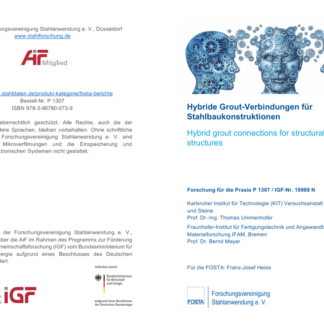Description
P 1307 – Hybrid grout connections for structural steel structures
Joints in steel construction are currently realised by welding, bolting and riveting. However, these joining methods have disadvantages. With adhesively bonded joints, components can be joined without these disadvantages. However, if, as in construction, due to unavoidable dimensional tolerances adhesive gap thicknesses ranging from several millimeters to centimeters are required between the adherents, conventional bonding methods are unsuitable. Another joining method for hollow sections, especially in the field of the foundation structures of offshore wind turbines, are grouted joints. In these large-scale tube-in-tube joints, the cylindrical joint gap is filled with a high-strength fine-grain mortar (grout). Due to the low adhesion of the grout to the tube wall, mechanical shear keys are welded onto the surfaces of the parts to be joined. However, their welds can in turn be starting points for damages in the grout and in the steel components.
The focus of the present research project is on an innovative, hybrid joining method for steel components, which uses grout and adhesive layers and combines them advantageously, taking into account the respective material properties. The hybrid grout joining technology features a novel, multilayer structure and is produced in several process steps. Under controlled conditions in the manufacturing plant, the blasted bonding surfaces of the structural components are first provided with a thin organic adhesive layer (e.g. epoxy resin), into which an inorganic granulate (e.g. corundum, quartz sand) is subsequently embedded. The actual form fit between the opposing parts to be joined is produced by filling a commercially available, highstrength grout into the remaining joint gap resulting in a two-dimensional interlocking of the grout with the inorganic granules. The bond between the adhesive layer, which is bonded to the steel surfaces and the grout, is produced by the strong interlocking of the inorganic granules.
Extensive analytical, experimental and numerical investigations were carried out for the systematic investigation of the hybrid grout connection. First, the steel, adhesive and grout materials to be used are selected and analysed based on a catalogue of requirements worked out in the project. The most efficient combinations of adhesive, grout material and granulate are determined in a series of tensile tests on hybrid grouted tube joints (small scale) and prioritised for further investigations. The influence of the parameters joint gap thickness, tube cross-sections, overlap length, imperfections and loading direction on the load-bearing behaviour under axial stress is subsequently determined for the two prioritised adhesive-grout combinations in extensive tests. In all test series, the hybrid grout joint shows a high load-bearing capacity (bond strengths up to 30 MPa). The investigated geometric imperfections do not result in a reduced load-bearing capacity. In bending tests on hybrid grouted tube joints, the bending behaviour is investigated as a function of joint gap thickness, overlap length and joint materials. In all the bending tests carried out in the project, the plastic load-bearing capacity of the tube cross-sections was achieved without any failure of the joint being detected. The investigation of the durability of the hybrid grouted joint represents a further research area. Tensile tests on tubular joints at -20 °C and +60 °C represent construction-relevant application temperatures. At low temperatures, for both adhesive materials the load-bearing capacity increases. At a test temperature of +60 °C, the load-bearing capacity of the joint decreases by a maximum of 20 %. The work package is supplemented by the quantification of the axial tensile load-bearing capacity after ageing the tube samples for 1000 hours in artificial seawater and after carrying out the temperature cycling test in accordance with VW PV1200. No reduction in the load-bearing capacity was observed for either of the two ageing scenarios. Against the background of the intended use of hybrid grout joints under non-static loading, fatigue tests are carried out. The load-bearing and failure behaviour of the hybrid grouted connection under non-static loading is investigated under axial compression load. Both adhesive-grout combinations show a high fatigue resistance. Based on the tests carried out, the fatigue strength of the hybrid grout connection is approx. 50 % of the quasistatic load-bearing capacity. Numerical simulations accompany the experimental investigations and are the basis for the development of design approaches. Based on the results of off-axis tests on bonded and hybrid grouted steel specimens, a fracture
criterion is developed for the hybrid grouted connection that takes into account the interaction of shear stresses in the bonded joint and normal stresses orthogonal to the bonded joint. The fracture criterion is statistically evaluated and successfully applied to determine the load-bearing capacity of the hybrid grout connection in a probabilistic design procedure. Finally, all findings obtained in the research project are combined in the manufacturing and experimental testing of large-scale components. For this purpose, compression tests are carried out on circular hollow sections with external diameters of approx. 270 mm and a nominal joint gap of 20 mm. With an overlap length of 150 mm, maximum load capacities of approx. 1700 kN on average are achieved.
The results of the research project demonstrate the performance of the new hybrid grouted joining technology. Due to the high load-bearing capacities determined in this project under quasi-static and non-static loading, as well as after ageing, the hybrid grouted joint has great potential for application in steel construction.
Published in:
2021
Authors:
Prof. Dr.-Ing. T. Ummenhofer, Prof. Dr. B. Mayer




